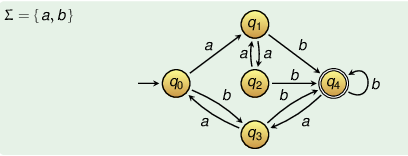Automata & Complexity
Table of Contents
Automata and complexity
Intro
Some problems are undecidable: program termination, post correspondence problem
Some are NP-complete - travelling salesman, satisfiability in prop. logic
Word: finite sequence of symbols from finite alphabet Σ
conventions:
- symbols: a, b, c
- words: u, v, w, x, y, z
- empty word: λ
computer program is a word, takes input word, produces output word
can concatenate words, |v| means length of word
power vk is k concatenations of v’s
reverse (a1 … an)R = an … a1
Formal languages
Formal language: set of words.
Σ* is set of all words over Σ, formal language L is subset of Σ*
Since it’s a set, the usual set operations have meaning (complement, union, intersection, etc.)
nth power of language is Ln+1 = Ln L
Kleene star: $L* = \bigcup_{i=0}{\infty} Li$, $L+ = \bigcup_{i=1}{\infty} Li$
$\overline{L}R$ == $\overline{LR}$
But sets are not the best for language description, so let’s use something else.
Deterministic Finite Automata (DFA)
Consists of:
- Q: finite set of states
- Σ: finite input alphabet
- δ : Q × Σ → Q: transition function
- q0 ∈ Q: starting state
- set F ⊂ Q of final states
If automaton in state q reads symbol a, resulting state is δ(q, a).
$(q, aw) \vdash (q’, w) \quad if \quad \delta(q, a) = q’$
You can write transition function δ in form of table:
| State | ||
|---|---|---|
| δ | q0 | q1 |
| a | q0 | q1 |
| b | q1 | q0 |
DFA transition graphs
DFA can be visualised as transition graph:
- states are nodes of graph
- arows with labels from Σ
- starting state: extra incoming arrow
- final states: double circle
- arrow q → q' with label a iff δ(q, a) = q'

if $(q, w) \vdash^* (q’, λ)$, can write $q \xrightarrow{w} q’$
A DFA defines a regular language based on what it accepts (or rejects).
To get a complement, you can just invert final states.
Determinism
Deterministic: for every state and symbol, any state q has only one outgoing arrow with label a
For every input word, there's exactly one path from starting state through transition graph
Theorems for regular languages
A language is regular if there is a DFA M = (Q, Σ, δ, q0, F) with L(M) = L
If L regular, $\overline{L}$ also regular.
If L1 and L2 regular, then L1 ∪ L2 regular.
If L regular, LR regular.
Every finite language is regular.